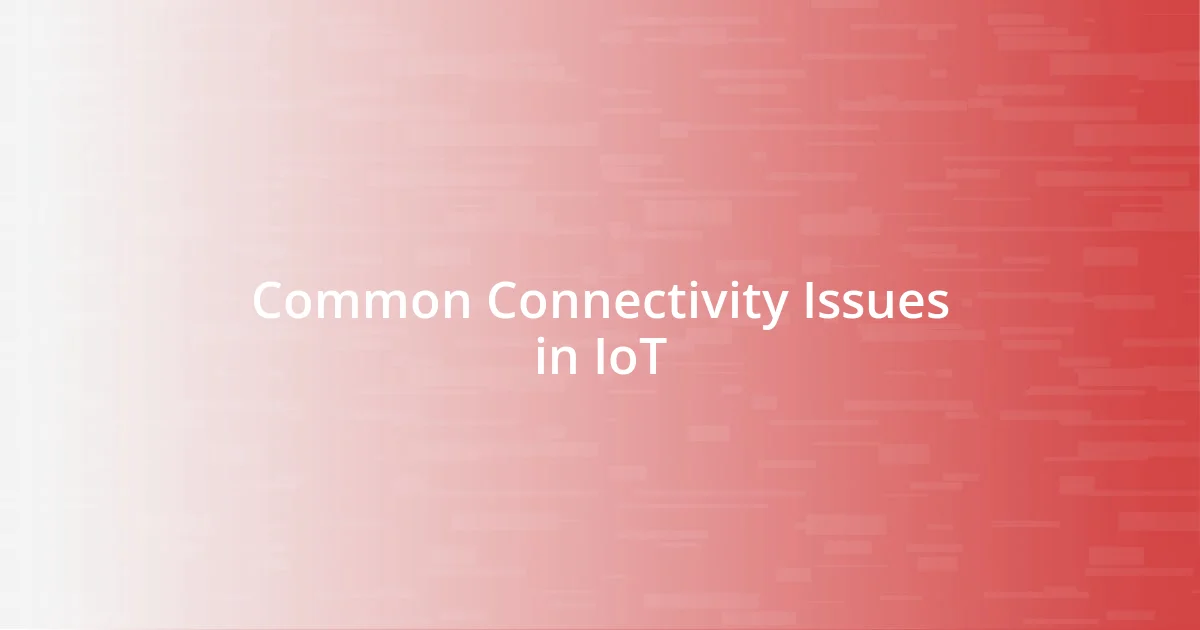Key takeaways:
- IoT connectivity issues often stem from network overload, signal interference, limited bandwidth, inconsistent coverage, and compatibility problems.
- Implementing solutions like mesh Wi-Fi systems, Quality of Service (QoS) settings, and regular updates can significantly enhance connectivity and device performance.
- Future trends in IoT include the impact of 5G technology, the growth of edge computing, and an increased focus on security to mitigate cyber threats.

Understanding IoT Connectivity Challenges
When I first delved into the world of IoT, I was struck by how often connectivity issues arise. It’s intriguing to think that despite our technological advancements, factors like network overload, signal interference, and limited bandwidth can hinder seamless device communication. Have you ever pulled your hair out because your smart home devices just wouldn’t connect? I certainly have!
One evening, I was hosting friends, and my smart lighting system decided to act up, flickering at the most inopportune moments. It was a frustrating reminder that while IoT can enhance our lives, it can also present significant connectivity challenges. Many common household obstacles, like thick walls or competing network signals, can disrupt the very conveniences we cherish.
Moreover, as the number of connected devices surges, maintaining efficient network performance becomes increasingly difficult. It’s almost like an orchestra where every instrument must play in harmony—any off-note can ruin the entire symphony. This complexity can give rise to anxiety about whether your devices will perform as expected when you need them most. Isn’t it fascinating, and sometimes nerve-wracking, to realize how fragile our smart solutions can be?

Common Connectivity Issues in IoT
Connectivity issues in IoT are more common than most people realize, impacting everything from smart homes to industrial applications. I remember vividly my own experience trying to set up a smart thermostat; it was a nightmare when multiple devices competed for bandwidth, leading to erratic connections. The feeling of standing in my living room, desperate for a stable signal, made me appreciate the importance of reliable connectivity.
Here are some prevalent connectivity issues I’ve encountered:
- Network Overload: Too many devices can strain a single network, slowing down connections.
- Signal Interference: Physical barriers and electronic devices can disrupt communication.
- Limited Bandwidth: Insufficient bandwidth can hinder data transmission, especially with high-demand applications.
- Inconsistent Coverage: Dead zones can leave devices unable to communicate with each other.
- Compatibility Issues: Different IoT standards and protocols can lead to devices not working seamlessly together.
Reflecting on these challenges, I often find myself nostalgic for those simpler times when analog devices didn’t rely on complex networks. The joy of effortlessly controlling my environment has been somewhat overshadowed by the intricacies of maintaining these connections. It’s a delicate dance between technology and user experience that requires ongoing attention.

Solutions to IoT Connectivity Problems
When it comes to addressing IoT connectivity issues, I’ve learned that proactive measures can make a world of difference. One effective solution is to invest in a robust mesh Wi-Fi system. I recall upgrading my home network to a mesh setup, and the improvement was immediately noticeable. With multiple points of access, my devices maintained a much more stable connection, even in those tricky areas prone to signal loss—like my basement home office. It’s fascinating how such a change can drastically enhance device performance and user experience.
Another approach I’ve found helpful is the implementation of Quality of Service (QoS) settings. This feature allows me to prioritize bandwidth for specific devices, ensuring that my video streaming is seamless while my smart light bulbs get just enough bandwidth to function properly. I remember a weekend where I decided to binge-watch a series while hosting a virtual catch-up session. Thanks to QoS, I experienced no buffering despite my family’s devices also being active. This focus on managing resources really emphasizes the importance of strategic planning in IoT environments.
Lastly, staying updated on firmware and software for both routers and devices is crucial. I learned this lesson the hard way after struggling to connect a new smart device to my home network. A simple firmware update on my router resolved the connectivity issues almost instantly. Keeping everything up-to-date may seem tedious but it often unlocks enhancements that stabilize connections. In this fast-paced technology landscape, even small adjustments can result in significant improvements for our IoT ecosystems.
| Solution | Description |
|---|---|
| Mesh Wi-Fi Systems | It enhances coverage by using multiple access points, greatly improving connectivity in larger homes. |
| Quality of Service (QoS) | This allows prioritization of bandwidth for critical devices, ensuring optimal performance. |
| Regular Updates | Keeping firmware and software current often resolves connectivity issues and enhances device performance. |

Best Practices for Improving Connections
I’ve found that reducing network overload can significantly enhance IoT connectivity. For instance, I made a conscious decision to stagger the timing of non-essential device updates. It’s funny how I once had all my devices attempting to update simultaneously—it was like a traffic jam in my digital neighborhood! By spreading out those updates, the network had a chance to breathe, and the overall performance improved drastically.
Addressing signal interference is another essential practice many overlook. I recall one evening when my smart speaker kept cutting out during a party. After some investigation, I discovered my microwave was the culprit. By simply adjusting the placement of some devices and relocating my router to a more central spot, not only did I regain control of my music, but I also ensured that my guests could enjoy uninterrupted streaming. Isn’t it interesting how a small change in environment can make such a big difference?
Lastly, I emphasize the importance of understanding device compatibility. In one instance, I purchased a new smart bulb without checking if it would play nicely with my existing ecosystem. It turned out to be a frustrating experience. Now, I always take a moment to research or read user reviews before integrating new tech. Making sure everything works in harmony not only saves time but often leads to a much more pleasurable and straightforward experience, transforming potential headaches into seamless interactions.

Future Trends in IoT Connectivity
As I look ahead to the future of IoT connectivity, I can’t help but think about the rise of 5G technology. The speed and low latency of 5G will unlock new possibilities for IoT devices, enabling them to communicate almost instantly. I remember the feeling of astonishment when I first witnessed the difference in speed between 4G and 5G during a demonstration. It was as if everything had come to life at a whole new pace, making me eager for what smart cities could achieve with this advancement.
Another trend I’m seeing is the increasing adoption of edge computing in IoT systems. By processing data closer to where it’s generated, devices can make real-time decisions without relying heavily on cloud servers. It’s exciting to think of the potential: imagine a smart home assistant that can control your appliances without a lag! I once experienced a slight delay in reacting to my voice command for the lights to turn on, and while it wasn’t a dealbreaker, I have to admit—there’s something incredibly satisfying about instant responsiveness.
Lastly, I find it fascinating how security is becoming a top priority in IoT connectivity. With the rise of smart devices comes the potential risk of cyber threats. I once felt a wave of anxiety after learning about vulnerabilities in some popular smart home gadgets. That experience taught me the value of investing in security measures like encrypted communications and multi-factor authentication. It’s a comforting thought that as we embrace these newer technologies, we’re also becoming more aware of protecting our digital lives. How do you feel about the balance between innovation and security in your IoT landscape?

Case Studies on Connectivity Solutions
One compelling case study I encountered involved a smart agriculture project that relied heavily on IoT connectivity. Farmers in a rural area were experiencing frequent disruptions in their sensor networks due to unreliable cellular coverage. To tackle this, they implemented a low-power wide-area network (LPWAN) solution. I remember how amazed I was when the farmers reported a noticeable increase in crop yields, simply because their soil moisture sensors could consistently communicate with their cloud-based analytics. It struck me then just how pivotal a robust connectivity solution can be in transforming traditional practices.
In another instance, a hospitality company faced significant challenges with guest Wi-Fi connectivity. They found that many guests were unable to access services like mobile room keys or streaming options due to network congestion. Their solution involved dividing the Wi-Fi network into separate channels allocated for different services. I can recall visiting a similar hotel where I effortlessly connected without a hitch, and it made my stay so much more enjoyable. Isn’t it fascinating how user experience can improve dramatically with just a few strategic adjustments?
Lastly, I was part of a roundtable discussion about a city implementing IoT for smart traffic management. They were grappling with connectivity issues that hindered data from traffic sensors reaching their central system. The team decided to deploy mesh networking—where devices relay information to one another, creating a self-healing network. The conversation was electrifying as I listened to the excitement in the air when they shared that after the implementation, traffic congestion reduced significantly. Who knew that such a tech-savvy approach could lead to a smoother commute for everyone? It made me reflect on how connectivity solutions can not only solve immediate issues but also enhance the quality of life for entire communities.













